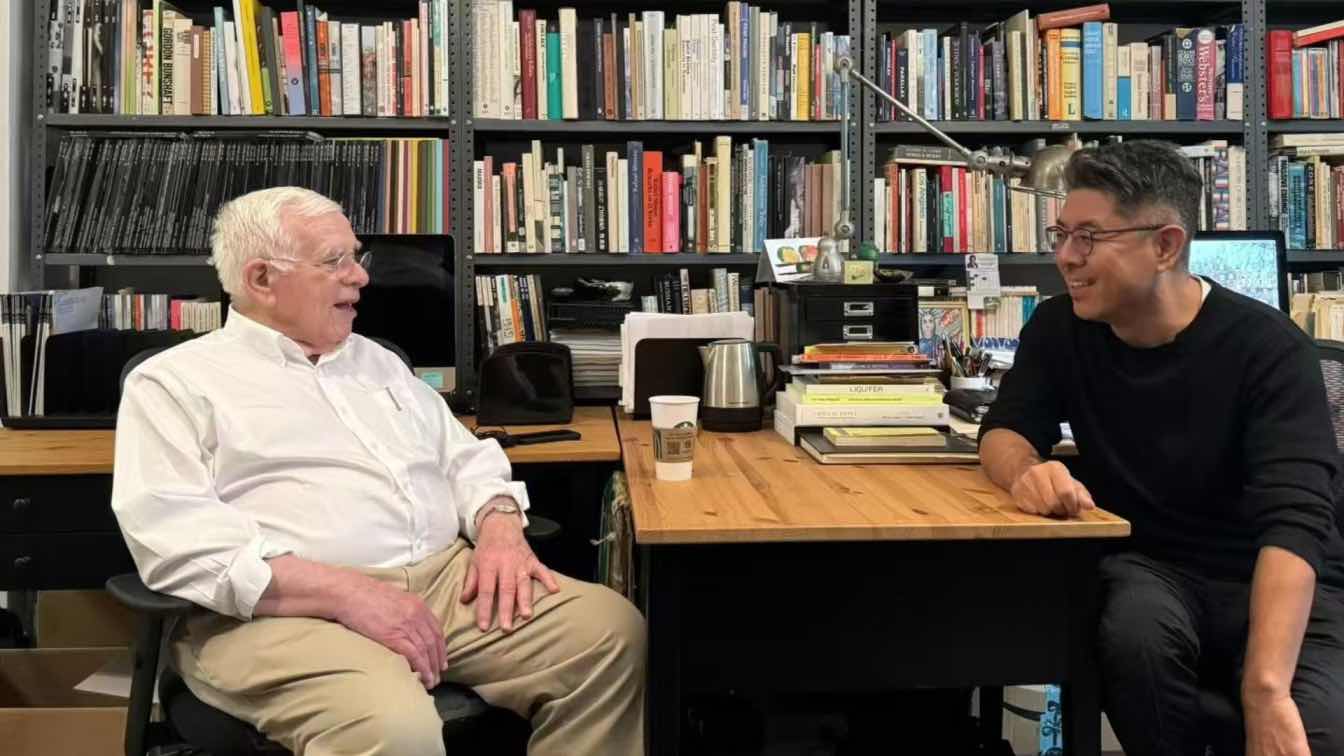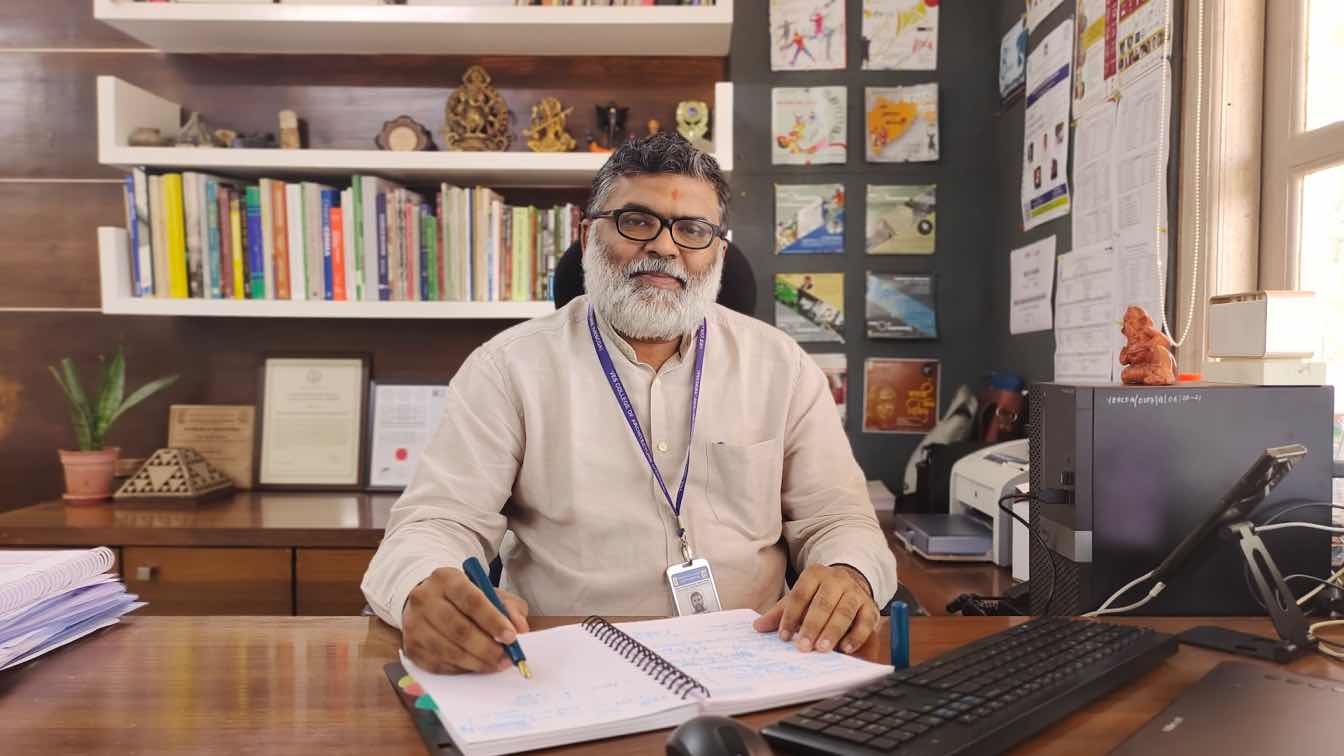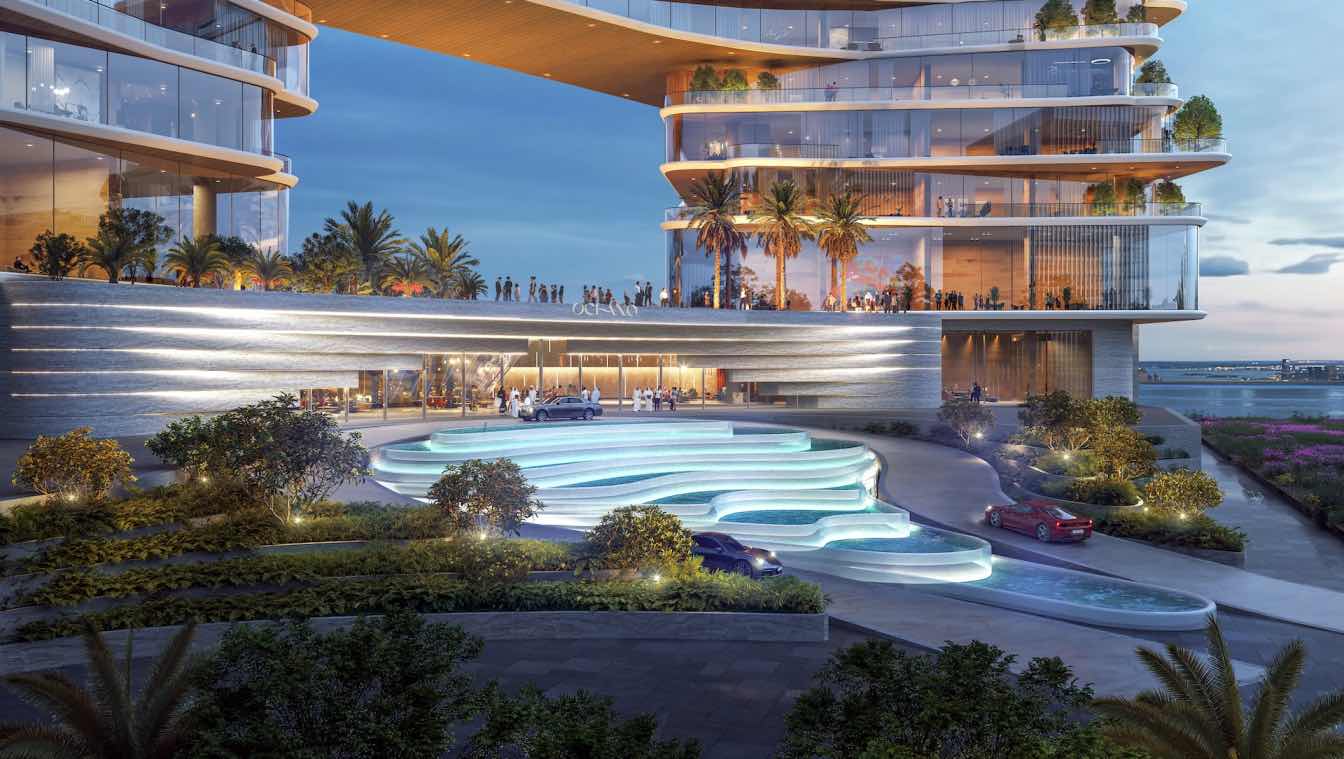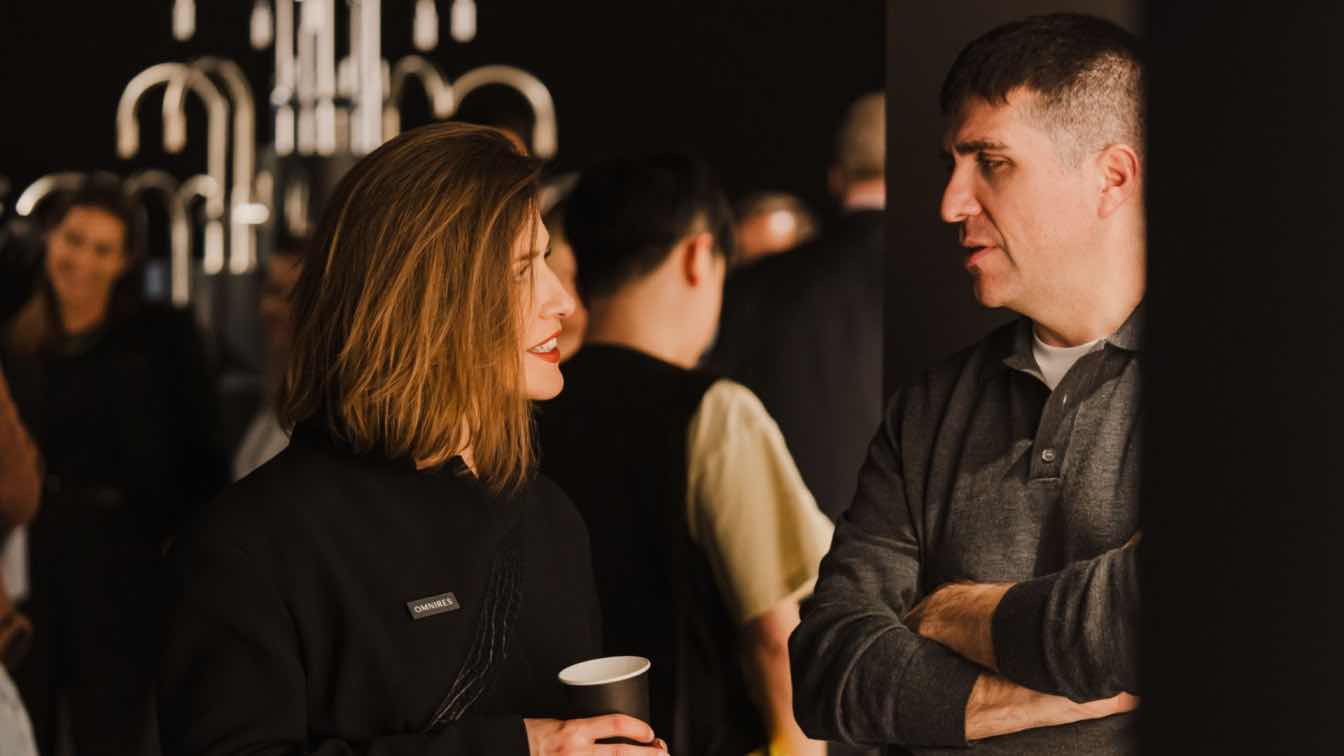In September 2024, as part of his debut architectural documentary series, A Rhapsody of Cities, Ma Yansong explored the cultural and architectural essence of six cities—Paris, Barcelona, Los Angeles, New York, Rotterdam, and Stuttgart—through conversations with renowned guests. While in New York, Ma engaged in a thought-provoking conversation with renowned architect and educator Peter Eisenman, exploring the intersections of culture, architecture, and unbuilt ideas.
Peter Eisenman: How many people are on your team?
Ma Yansong: We have teams in Beijing, Los Angeles, and Rome. The Beijing team is relatively large, with about 140 people; the Los Angeles studio is a small one, with 20 people.
Peter Eisenman: That's great. Have I taught you a design class before?
Ma Yansong: No, but I interned here during the summer of 2001.
Ma Yansong: I participated in two European projects during my internship, one of which was the Memorial to the Murdered Jews of Europe in Berlin. This project is very good, and I visited it several times.
Peter Eisenman: It’s not bad. Doing a memorial is very difficult, but it works.
In China, the culture of architecture begins to permeate down through society
Peter Eisenman: I am currently teaching at Cornell University and have 19 students, 12 of whom are from China. There are quite a lot of differences between Chinese and Japanese architecture. I am currently teaching a course on Western architectural history theory. Japanese architects have absorbed Western architecture, such as Arata Isozaki, Kisho Kurokawa, Kenzo Tange, etc. They have all been westernized.
But China is completely different. In the past ten years, the influence of the Chinese has become very important. I tell Chinese people that after going to China, I have a different view of the country. The culture of architecture, I mean not only the building, but the culture has to permeate down through the society. Now, that is happening in China.
Ma Yansong: I am also part of it. Twenty years ago, I was one of the young students who went to the West to study architecture; I returned to China just as China began to rapidly urbanize and focus on urban construction, so young architects like me got some opportunities.
Peter Eisenman: Many Chinese students want to study architecture, which is actually Western architecture. I think the difficulty you are facing now is that the young people we are educating now are already Westernized and are not prepared for work in Beijing, Shanghai, and other places.
Ma Yansong: The Chinese market has also experienced Westernization in the past 20 years. What do you think? Of course, it is different now.
Peter Eisenman: Shanghai has different settlements, such as the French Settlement and the British Settlement. They began to influence China in the 1920s and 1930s. But these were backward influences, not avant-garde influences. But now, the situation in China has changed, and there are more avant-garde works.
The Unbuilt Eisenman
Peter Eisenman: We have an exhibition (in China) that has been in preparation for three or four years. It plans to display 29 unbuilt projects selected by my team, as well as some books I am writing. So, this exhibition is not only about architecture, but also about books and design. I plan to name it Unbuilt Eisenman.
Ma Yansong: You think your unbuilt projects are important to the world.
Peter Eisenman: I hope it will be influential.
Ma Yansong: Why do you think showing unbuilt projects will benefit young people in China?
Peter Eisenman: I think it will benefit not only young Chinese architects, but all young architects, because most of the unbuilt projects contain the mature ideas about architecture that I teach. The reason why they were not built is usually because that is not what the client wants, but they show the ideas I want to convey.
I have some very good unbuilt projects and there are lots of those ideas that are floating around that could be built by Chinese. You could take something and riff on it, taking it in a different direction.
I'm not planning to do any of these projects right now, because I don't want to go back to building. I've only been writing books lately, and I just finished a book last week about the Roman architect Leon Battista Alberti.
I'm writing three books right now: one about postmodernism; one about four architects—Aldo Rossi, Oswald Mathias Ungers, James Stirling, and Robert Venturi, whom I call "postmodernist architects"; and the last one is Formal Analysis, which was a required course when I taught at Yale University, and I'm still teaching this course at Cornell University until next year, and then they will publish the book. This book covers my teaching ideas at Yale University for 25 years, including the projects we did, the formal analysis projects we did, etc. I believe it will be a very interesting book.
I have a lot of architectural theories, and it is very important for me to spread them.
Ma Yansong: You think ideas are more important. You made a lot of drawings, such as the drawings for the Unbuilt Eisenman exhibition, which I think have a great influence on young students. (Pointing to the sketchbook that Eisenman took out) Is this seemingly postmodern drawing a sketch in your book?
Peter Eisenman: This is my notebook from 1980, and the contents inside are all drawn in that year.
We are creating the future from fragments
Ma Yansong: Why are you interested in classical architecture and postmodern architecture, but you also do some very avant-garde projects?
Peter Eisenman: This is a very tough question. I believe in something called precedents. I believe we have to learn, which is why I wrote about Alberti.
Alberti was a very important architect of the 16th century who designed only five buildings in his lifetime but wrote ten books on architecture that expounded on a very important and radical philosophy of architecture. I am studying five of Alberti's buildings in the hope that I can use them as precedents and invent off of that to create different buildings with my students. These “different architectures” are not “postmodern,” I call them “post-digital” architecture.
For example, we are working on the concept of "fragment," which is related to modern architecture. The harmonious proportion of the part and the whole, Le Corbusier, etc., have disappeared. There is no idealism now, and there is no concept of "part." "Part" is "fragment"; we are dealing with "fragment," which is a completely "postmodernist" concept. But we’re inventing from the fragment into the future.
I hope that future generations can develop and innovate based on my theory.
Peter Eisenman: I want to discuss the architecture of the next wave in these publications. If I live another 20 years, I will build (what I think is the future of architecture); but now I have only theories and drawings, but it is enough to explain what I am doing.
In five years I will publish these theories, and then young architects like you can implement my concepts. I am happy to accept.
Ma Yansong: I am surprised that you said that you want people to borrow your ideas and designs by doing exhibitions.
Peter Eisenman: I don't want them to take my work directly. I don't want them to follow, but to develop and innovate based on my ideas.
Ma Yansong: When I was here 20 years ago, several of your buildings were under construction, but there were more sketches that looked very crazy, such as the twisted building on Hudson. These encouraged young architects like me. I used to think that architects should do this kind of (projects).
Peter Eisenman: I have published a book about ten canonical buildings, Architectural Classics: 1950-2000, a book about Andrea Palladio, Virtual Palladio, and a book about Le Corbusier, Eisenman Inside Out: Selected Writings, 1963-1988. I have published many theoretical books, but now I want to update my ideas from 20 years ago, so I need to do new theoretical work, just like I draw these things in my notebook.
If (these) are feasible, then Chinese architects, Japanese architects, and Korean architects can use it.
We must strive to create a contemporary "Chinese model"
Peter Eisenman: I see a lot of me in your work. If you ask me which architect has influenced you, I think I would be one of them. That's why I want to meet you.
Ma Yansong: You have been teaching for many years. Why do you think teaching is so important? I remember when I was in school, you invited Philip Johnson for a review.
Peter Eisenman: We are very good friends.
Ma Yansong: Is it also a way for you to sort out your theories?
Peter Eisenman: Of course. Suppose I were your teacher today and you asked me to explain why I designed it this way. I have to explain.
Writing and drawing are both very important. My students must be able to draw their ideas. They have to draw once a week. They have to draw in the style of Francesco Borromini, or Mies van der Rohe, or Le Corbusier. But now I don't have any models for young Chinese architects to follow, and I don't have any "Chinese model" to develop and create based on it.
So the important thing is that there is no "Chinese model" compared to Japan, Italy, Germany, and Russia. If you want to make some achievements in history, you have to work hard to create a contemporary "Chinese model."
I believe that would be a worthwhile thing to do. It’s a wide-open field for the Chinese, because the next Chinese Pritzker Prize winner will come from your generation, from those architects who create the "Chinese model" for China. This is why I want to meet you, because you are one of the young people with potential that I mentioned.
It is difficult for architects to produce truly mature works before the age of 50
Peter Eisenman: It is very difficult for architects to produce truly mature works before the age of 50.
Ma Yansong: That is why I came back to Yale to teach, to follow in your footsteps. In that era, you were like heroes, coming up with ambitious ideas, theories, and proposals. Do you think the situation has changed?
Peter Eisenman: No one is coming up with more ideas now because it is not the right time yet. When you are 50, you can consider coming up with some crazy ideas again. That is my feeling. In three to five years, the situation will change, but it is not the right time yet.
I just want to keep going because I feel enough energy to do that. I can't just sit there, so I am teaching, writing, and thinking. I just want to do a small project, not 20 huge buildings.
In the past ten years, China has become more and more open, and more and more people are interested in interconnection, so we are able to meet today.
I teach undergraduate and graduate courses, and my students are excellent, but if they want to be architects like you, they must have the passion and spirit to do this, not just do drawings.
After the Deconstructivist Architecture Exhibition, architectural thought fell silent
Ma Yansong: Speaking of exhibitions, I remember the Deconstructivist Architecture exhibition at MoMA in 1988. It was a great exhibition. How old were you then?
Peter Eisenman: 56.
Ma Yansong: Six years after 50.
Peter Eisenman: After that exhibition, no more exciting ideas were produced. In addition to me, the participants in that exhibition included Frank Gehry, Rem Koolhaas, Wolf de Prix, Bernard Tschumi, and Zaha Hadid, each of whom was a star in the architectural world. It was indeed an interesting exhibition, but it was 36 years ago.
Ma Yansong: But every participant was successful, and the exhibition was very influential. You were all young architects at that time.
Peter Eisenman: Yes, after that exhibition, everyone was on the rise, then there was a decline, and now it is gradually rising again. But this rise does not refer to us.
Ma Yansong: Do you still think your architecture is avant-garde now?
Peter Eisenman: I don’t think my architecture is avant-garde. I think my architecture is of the culture. Avant-garde means before culture, but my architecture is not separated from culture. It is not outside of culture, nor before culture.
This is also the reason why I hope you read the book Lateness, because Lateness is a concept of "behind," not "avant-garde," but "derniere-garde," the latest trend of thought.
To influence what should be built and how it should be built
Peter Eisenman: I don't define architects by nationality. If you want to have a broader career, you can set up a joint venture school with Yale, and then in two years, you may become the new dean of the Yale Department of Architecture.
Ma Yansong: Only if I build fewer projects can I do this (laughs).
Peter Eisenman: In fact, you don't need to build so many buildings. In your lifetime, five masterpieces are enough. How many masterpieces did Le Corbusier have in his lifetime? How many masterpieces did Venturi have? How many masterpieces did Aldo Rossi have? Not so many.
You don't have to build so many. But you can be in an influential position to influence what should be built and how to build it. If you can become the dean of Yale, the types of projects you can do and the cultural importance of the projects will be different.
If I were in your current position and age, I would go to Yale to be the dean, regardless of nationality.
Ma Yansong: This is a good suggestion (laughs).
Peter Eisenman: I think so too, don't tell anyone.
Ma Yansong: We are recording a show, and everyone in front of the camera will know (laughs).
The core spirit of New York is the mixing of cultures
Ma Yansong: Is New York important to you?
Peter Eisenman: There is no architecture in New York. We only have the Guggenheim Museum. If I want to see architecture, I will choose Milan, Berlin, London, Paris, but definitely not New York.
Ma Yansong: (Also) Central Park.
Peter Eisenman: Yes, Central Park is great because it is real nature.
Ma Yansong: What do you think of those pencil-like skyscrapers? They are unique to New York and cannot be seen anywhere else.
Peter Eisenman: I always ask my students: Please write down the reasons why skyscrapers are not (good architecture). In reality, skyscrapers are very crowded with traffic: people are crowded together when going downstairs, and there are many people taking taxis.
Now I can only travel by taxi. If I get off a skyscraper and 20 people are trying to get a taxi at the same time, it’s terrible. I don’t mind the concept of skyscrapers, but maybe they shouldn’t be so super tall.
I like the scale of Chicago. It’s a great city and a city I would go to because there are works by Frank Lloyd Wright, Louis Sullivan, SOM, Mies van der Rohe, and others.
Also, what I am dissatisfied with about New York is that our New York Times, one of the most important newspapers in the world, does not have an architectural critic section. Architectural culture does not exist in New York.
Ma Yansong: Have you ever considered writing some architectural critics?
Peter Eisenman: I am 92 years old now, and I can’t write very good articles easily. (Writing architectural critics) will take me a lot of time. What I do now is reading.
Program team: What do you think is the core spirit of New York? Or what is the core spirit of New Yorkers? As Chinese, we think the core spirit is freedom, or something similar. So as a New Yorker, what do you think?
Peter Eisenman: I think (the core spirit) is the mixing of cultures. We have European music and food, as well as delicious Chinese food.
The advantage of New York is that there are always shops open. Even at 11 o'clock in the evening, I can go downstairs to buy the milk, cheese, or coffee I want, although it is not very convenient for me to go up and down the stairs.
Public transportation in New York is also very convenient. You can choose subways, buses, private cars, and taxis to travel. I like New York very much.
Look at things from a historical perspective, not from the present
Program team: The last question is about the Chinese architect community. You just mentioned that architects should be passionate about architecture. But right now in China, especially in the field of architecture, people are experiencing a great depression. Architects are suffering. There are not enough projects, and architecture schools cannot recruit enough students. People are no longer excited about this profession. Everything has slowed down.
Peter Eisenman: All cultures are cyclical and will fluctuate up and down. It is impossible to maintain an upward (trend) forever.
We are in a downturn, and the situation you described is indeed happening. Now is not a good time for architecture, and everyone agrees on this.
Architects suffer, so what? To be good, you have to suffer.
You can't win every competition. I built about 30 projects and lost 30 good projects. That’s why I think Unbuilt is so important.
It’s not the right time yet, the right clients haven’t come yet. There’s not enough energy in the system. There’s no Philip Johnson, I.M. Pei, James Stirling, Aldo Rossi, Rem Koolhaas, Rafael Moneo, etc. There’s no anybody.
How many people have interviewed me before? No. So he (Ma Yansong) is really unusual, and I’m happy to talk to people. But it doesn’t mean that the industry is on the rise, although it will pick up eventually, maybe when Ma Yansong is 50 years old.
There is nothing now, so everything has to be rebuilt slowly.





